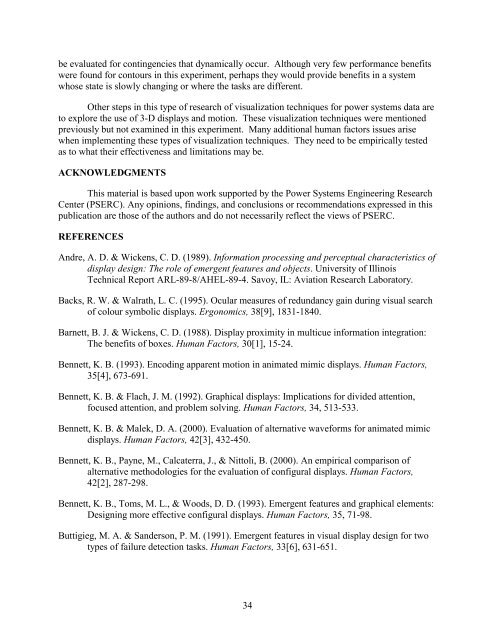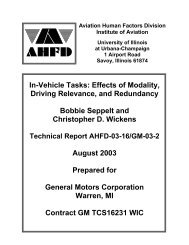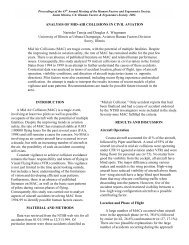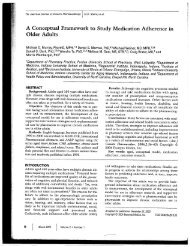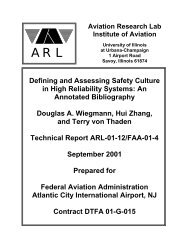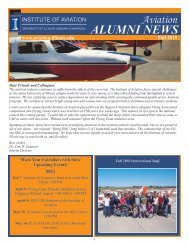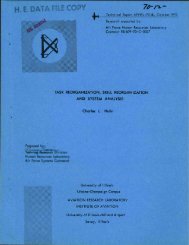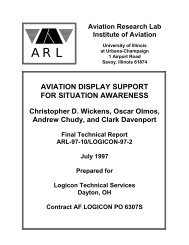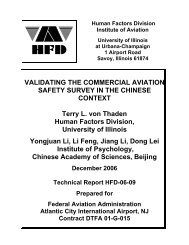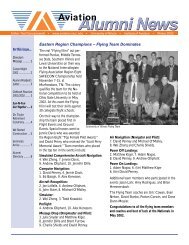Usability Questionnaire Results - Institute of Aviation - University of ...
Usability Questionnaire Results - Institute of Aviation - University of ...
Usability Questionnaire Results - Institute of Aviation - University of ...
Create successful ePaper yourself
Turn your PDF publications into a flip-book with our unique Google optimized e-Paper software.
e evaluated for contingencies that dynamically occur. Although very few performance benefitswere found for contours in this experiment, perhaps they would provide benefits in a systemwhose state is slowly changing or where the tasks are different.Other steps in this type <strong>of</strong> research <strong>of</strong> visualization techniques for power systems data areto explore the use <strong>of</strong> 3-D displays and motion. These visualization techniques were mentionedpreviously but not examined in this experiment. Many additional human factors issues arisewhen implementing these types <strong>of</strong> visualization techniques. They need to be empirically testedas to what their effectiveness and limitations may be.ACKNOWLEDGMENTSThis material is based upon work supported by the Power Systems Engineering ResearchCenter (PSERC). Any opinions, findings, and conclusions or recommendations expressed in thispublication are those <strong>of</strong> the authors and do not necessarily reflect the views <strong>of</strong> PSERC.REFERENCESAndre, A. D. & Wickens, C. D. (1989). Information processing and perceptual characteristics <strong>of</strong>display design: The role <strong>of</strong> emergent features and objects. <strong>University</strong> <strong>of</strong> IllinoisTechnical Report ARL-89-8/AHEL-89-4. Savoy, IL: <strong>Aviation</strong> Research Laboratory.Backs, R. W. & Walrath, L. C. (1995). Ocular measures <strong>of</strong> redundancy gain during visual search<strong>of</strong> colour symbolic displays. Ergonomics, 38[9], 1831-1840.Barnett, B. J. & Wickens, C. D. (1988). Display proximity in multicue information integration:The benefits <strong>of</strong> boxes. Human Factors, 30[1], 15-24.Bennett, K. B. (1993). Encoding apparent motion in animated mimic displays. Human Factors,35[4], 673-691.Bennett, K. B. & Flach, J. M. (1992). Graphical displays: Implications for divided attention,focused attention, and problem solving. Human Factors, 34, 513-533.Bennett, K. B. & Malek, D. A. (2000). Evaluation <strong>of</strong> alternative waveforms for animated mimicdisplays. Human Factors, 42[3], 432-450.Bennett, K. B., Payne, M., Calcaterra, J., & Nittoli, B. (2000). An empirical comparison <strong>of</strong>alternative methodologies for the evaluation <strong>of</strong> configural displays. Human Factors,42[2], 287-298.Bennett, K. B., Toms, M. L., & Woods, D. D. (1993). Emergent features and graphical elements:Designing more effective configural displays. Human Factors, 35, 71-98.Buttigieg, M. A. & Sanderson, P. M. (1991). Emergent features in visual display design for twotypes <strong>of</strong> failure detection tasks. Human Factors, 33[6], 631-651.34


